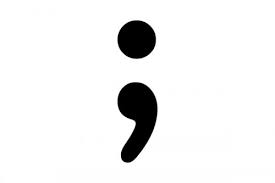The rules for using a semi-colon are fairly easy to understand. Let me quickly explain when and how to use a semi-colon.

When to Use a Semi-colon
A semi-colon should join two sentences that are related. This usually means they are about the same topic.
Examples:
- Water is important; we cannot live without it. (Both sentences are about water.)
- John didn't have any money; neither did I. (Both sentences are about the lack of money.)
- There was no other way to get home; we had to walk. (Both are about the same problem.)
As you can see, you should not use a capital letter in the first word after a semi-colon.
How to Use a Semi-colon
A semi-colon joins two complete sentences. It function in the same way as a period. Anytime you can use a period, you can also use a semi-colon (but you should only do so if the ideas are closely related).
This isn't as easy as it sounds though because you need to be able to identify what a complete sentences is. Briefly, a sentence always has an independent clause (IC), and sometimes it can have one (or more) dependent clauses (DC) (also known as subordinate clauses). Here are some examples of structures:
Correct Examples:
IC ; IC. (two Simple sentences joined with a semi-colon)
She was right; I wasn't prepared.
IC + DC ; IC. (a Complex sentence and a Simple sentence joined by a semi-colon)
I like to sing when I take a shower; it's my favourite part of the day.
Incorrect Examples:
DC ; IC
Because I was feeling unwell; I stayed home.
IC ; DC
You can join us; if you want to.
The first example should be joined by a comma, not a semi-colon. The second does not need punctuation. Again, a semi-colon can only join independent clauses or complete sentences. The clauses "Because I was feeling unwell" and "if you want to" are dependent clauses (subordinate clauses). They are not complete sentences because they do not express a complete thought.
In summary, use semi-colons between two complete sentences (complete thoughts) that are closely related.
- This is a complete sentence; this is also a complete sentence. (IC; IC = correct)
- This sentence is is a complete thought because you can completely understand it; therefore, you can use a semi-colon after it. (IC DC; IC = correct)
If you have a question; ask me below(incorrect because 'if you have a question' is not a complete sentence)
My Advice: Use Semi-colons Sparingly
This means to not use them in every sentence, paragraph, or e-mail. I use one semi-colon a week. I think that's about right. Some people think that the only purpose of a semi-colon is to show off to your reader. They may be right. Using a period between sentences the standard.
I hope this has been helpful. Feel free to ask a question below.
-- Matthew Barton / Creator of Englishcurrent.com
Related Pages

The best website .Thank you to this site created person